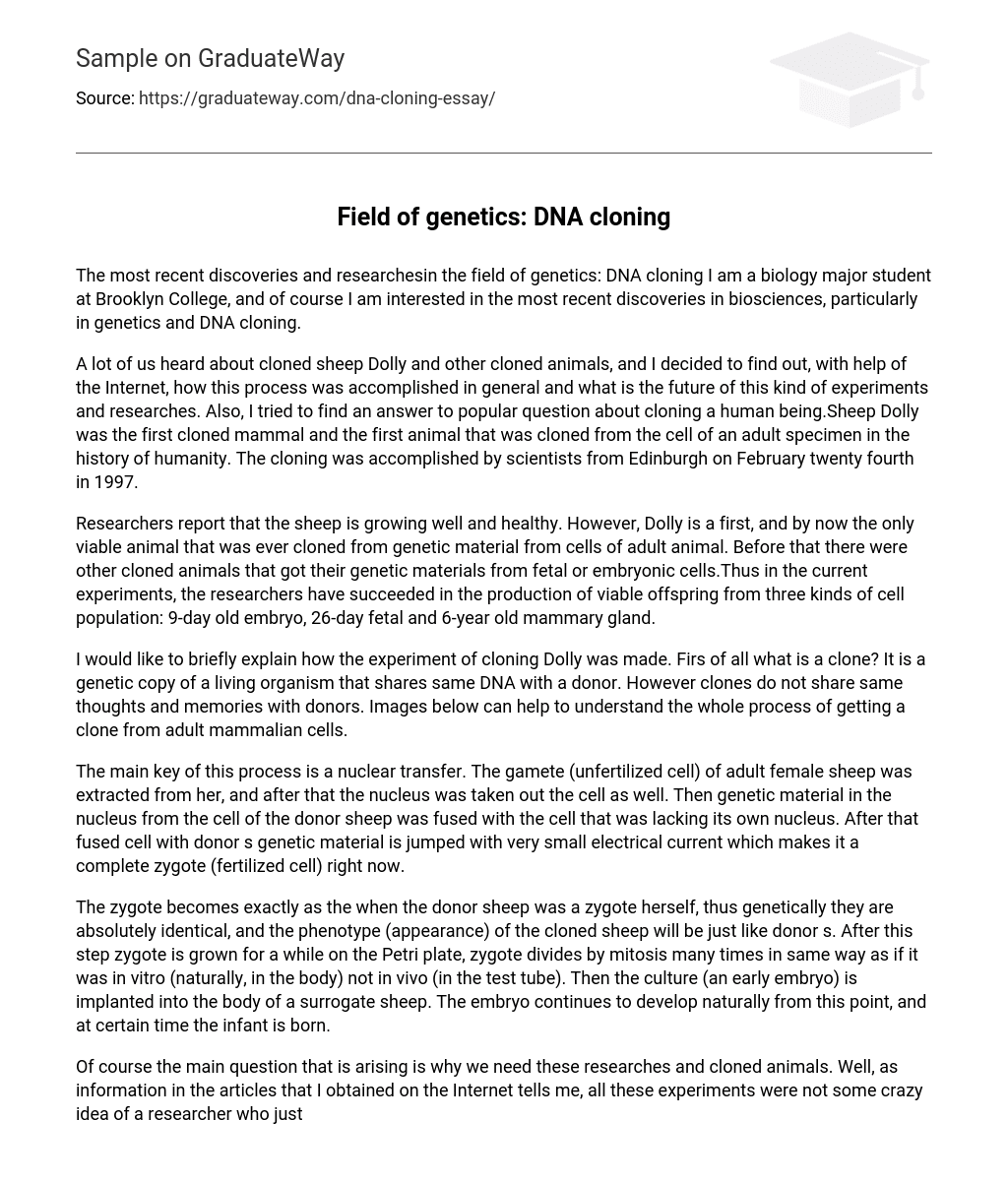The most recent discoveries and researchesin the field of genetics: DNA cloning I am a biology major student at Brooklyn College, and of course I am interested in the most recent discoveries in biosciences, particularly in genetics and DNA cloning.
A lot of us heard about cloned sheep Dolly and other cloned animals, and I decided to find out, with help of the Internet, how this process was accomplished in general and what is the future of this kind of experiments and researches. Also, I tried to find an answer to popular question about cloning a human being.Sheep Dolly was the first cloned mammal and the first animal that was cloned from the cell of an adult specimen in the history of humanity. The cloning was accomplished by scientists from Edinburgh on February twenty fourth in 1997.
Researchers report that the sheep is growing well and healthy. However, Dolly is a first, and by now the only viable animal that was ever cloned from genetic material from cells of adult animal. Before that there were other cloned animals that got their genetic materials from fetal or embryonic cells.Thus in the current experiments, the researchers have succeeded in the production of viable offspring from three kinds of cell population: 9-day old embryo, 26-day fetal and 6-year old mammary gland.
I would like to briefly explain how the experiment of cloning Dolly was made. Firs of all what is a clone? It is a genetic copy of a living organism that shares same DNA with a donor. However clones do not share same thoughts and memories with donors. Images below can help to understand the whole process of getting a clone from adult mammalian cells.
The main key of this process is a nuclear transfer. The gamete (unfertilized cell) of adult female sheep was extracted from her, and after that the nucleus was taken out the cell as well. Then genetic material in the nucleus from the cell of the donor sheep was fused with the cell that was lacking its own nucleus. After that fused cell with donor s genetic material is jumped with very small electrical current which makes it a complete zygote (fertilized cell) right now.
The zygote becomes exactly as the when the donor sheep was a zygote herself, thus genetically they are absolutely identical, and the phenotype (appearance) of the cloned sheep will be just like donor s. After this step zygote is grown for a while on the Petri plate, zygote divides by mitosis many times in same way as if it was in vitro (naturally, in the body) not in vivo (in the test tube). Then the culture (an early embryo) is implanted into the body of a surrogate sheep. The embryo continues to develop naturally from this point, and at certain time the infant is born.
Of course the main question that is arising is why we need these researches and cloned animals. Well, as information in the articles that I obtained on the Internet tells me, all these experiments were not some crazy idea of a researcher who just wanted see himself as a Creator. These recent genetic can be very helpful in different aspects of life. First of all, why sheep and not dogs were chosen for the experiment? The answer is that you can use some special kind of sheep as the donor who are immuned from certain diseases well and has good productivity.
Cloning can be used for treatment of certain animal diseases, such as mad cow syndrome, as well. So, cloning is very important in agriculture today. Also, it benefited modern animal genetics itself: regulation of gene expression, process of aging and various cases of cancer are better understood on molecular genetic level thanks to the discovery of mammalian cloning process. Also, custom-modified transgenic animals are needed in very small amounts make any kind of researches, and are ideal tool in medicine too: proteins and enzymes they make can be used for treatments of human diseases.
Cloning is a perfect switch that can turn bad genes off and turn good one s on. New discoveries in genetical cloning are very important for plants too. Cloning helped to create various hybrids, such as nectarines. Also, in it helps to give high yield of crops.
However, there can be disadvantage that offspring will not be viable, or will not reproduce naturally. The other disadvantage is that it is expensive process since in case with plants large quantities of clones are needed. Although discovery of cloning puts humans on one step higher in the process of evolution, it still carries some disadvantages with it.First of all, the is a disadvantage of monoculture: the basics of cloning is that offspring is identical with parents, which means that if the donor was affected in any way genetically and it was not noticed the recipient will be affected as well.
This is crucial if large offspring is obtained, as it happens in agriculture. Second of all, ethical issues about cloning are concerned too. Some organizations that defend animals and go against experiments on them argue that animal cloning is unnatural and these kinds of experiments should be stopped.





